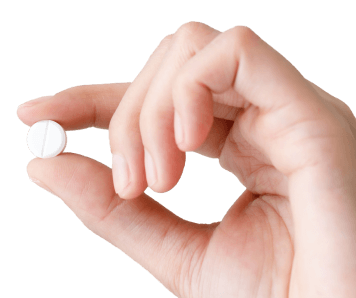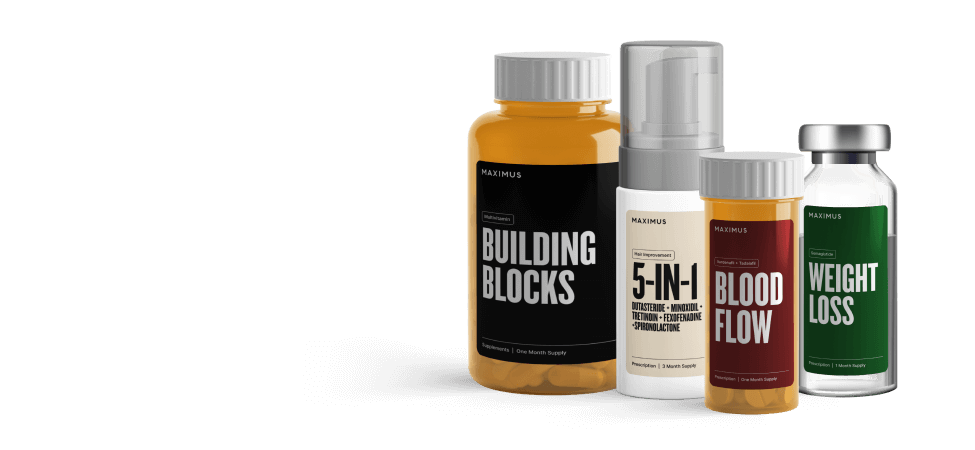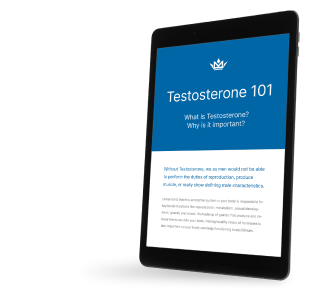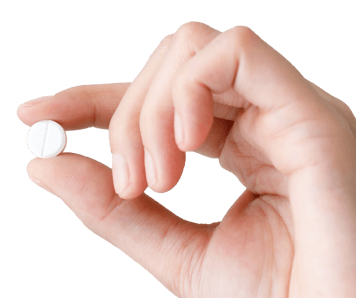If you want to know where your testosterone levels stand without the hassle and wait involved in a clinic visit, at-home testosterone testing offers a way to check your hormone levels without stepping outside of your home.
These tests provide valuable insights into your hormone health with just a small blood or saliva sample. But as the popularity of at-home tests increases, so do the questions:
Are at-home testosterone tests accurate? And if so, which method is best—finger prick, Tasso, or saliva?
Importantly, what do these results tell you about your health?
Read along as we demystify at-home testosterone testing so you can make empowered, informed decisions.
What types of at-home testosterone tests are available?
At-home testosterone tests are a convenient way to check your hormone levels without visiting a clinic. These tests typically fall into two main types: blood tests and saliva tests.
Blood tests:
At-home blood tests typically use either a finger prick method or a blood lancet device, like the Tasso. Both methods use capillary blood rather than venous blood, which is typically drawn in a clinical setting.
Testosterone blood tests can provide more information than saliva tests, such as total testosterone, free testosterone, sex hormone-binding globulin (SHBG), and luteinizing hormone (LH) levels.
Finger-prick test
Finger-prick blood tests involve a simple finger prick to collect a small blood sample, which is then sent to a certified lab for analysis. This method is simple, minimally invasive, and requires minimal training and equipment. However, finger-prick testing may be unreliable due to significant variability in results, even within the same individual.
One study found that hemoglobin levels could differ by more than 2 g/dL between consecutive drops of blood, with similar inconsistencies in platelet and white blood cell counts. The small blood volumes used in these tests also amplify errors caused by minor differences in technique or physiological factors—such as squeezing the finger, which can dilute the sample with interstitial fluid.
Additionally, a BMJ report highlighted that finger-prick hormone tests for estradiol showed a negative bias compared to venous samples, prompting some labs to discontinue their use over accuracy concerns.
Tasso device test
The Tasso device is a newer tool designed for at-home blood testing, offering a minimally invasive and user-friendly alternative to traditional blood draws.
Compared to the finger prick method, the Tasso device draws a larger blood sample from the upper arm, reducing user error and improving sample consistency.
Curious how it works? The Tasso device attaches to the skin and uses a small lancet with gentle vacuum pressure to draw capillary blood with minimal discomfort.
The collected blood is then transferred into a collection tube or dried on a specialized medium.
This type of test simplifies the blood collection process, making it suitable for unsupervised, at-home use when clear, step-by-step directions are provided.
Saliva tests:
Saliva-based testosterone testing offers a simple and non-invasive method for assessing active steroid hormone levels. All that’s required is for the user to thoroughly rinse the mouth with water and then spit into a small tube after.
However, despite the ease and simplicity, saliva-based testosterone tests offer less information than blood tests. This is because they provide information only about the free, unbound fraction of testosterone in the body.
Factors like sample collection time can also influence results. And, because saliva is easily contaminated by food, drink, brushing teeth, or even oral inflammation, the accuracy of the test may be compromised. However, research suggests these effects can be minimized with proper protocols in place.
Are at-home tests truly accurate?
When done correctly, at-home testosterone tests can provide accurate data, giving you insight that helps support physical performance, enhance emotional well-being, boost energy, and detect early signs of hormone imbalances. But not all methods offer the same level of accuracy. Some factors that play a role here include:
- Collection method: Blood tests are typically more reliable than saliva tests, providing more comprehensive insights into both total and free testosterone levels.
- Sample quality: Proper handling and quality of the sample are critical for accurate results.
- Lab processing; Tests processed by CLIA-certified labs are more reliable due to rigorous standards
Saliva tests only offer insight on free testosterone levels, which doesn’t provide a complete picture of your hormonal health. Blood tests, on the other hand, offer a broader view by testing multiple aspects of hormonal health, including free testosterone and total testosterone.
Even among blood tests, accuracy can vary. At-home testosterone blood tests that use finger pricks or blood lancets both rely on capillary blood. But studies show that finger-prick tests can be prone to contamination, and small sample sizes can lead to inaccurate results.
Blood lancet devices like the Tasso collect blood from the upper arm, providing a larger sample and typically causing less pain compared to finger pricking. These methods help reduce contamination risks, though sample size still plays a role in accuracy.
Using a trusted form of testosterone testing is crucial, as inaccurate tests can lead to unnecessary interventions or misdiagnosis.
Finger prick vs. tasso test: A direct comparison
When choosing an at-home test, accuracy and comfort are both important. Here's how the two most common blood-based methods stack up:
The Tasso device may offer a more comfortable and user-friendly experience compared to the traditional finger-prick method, generally with less risk of user error.
While both methods collect small volumes of blood, Tasso allows for slightly more, allowing for more comprehensive testing.
Tasso’s automated process reduces user error and preserves sample integrity for up to 28 days at room temperature, making it ideal for modern, at-home diagnostics. However, the method is newer and isn’t as widely available.
What’s inside Maximus’ At-Home Lab Tests?
Maximus offers two tiers of testing, both designed to give you deep insight into your hormonal health within days. These include the Standard At-Home Lab Test and the Advanced At-Home Lab Test.
Standard At-Home Lab Test
Maximus’ Standard At-Home Lab Test measures nine important biomarkers, including total testosterone, free testosterone, sex hormone-binding globulin (SHBG), and more. This test offers insight into baseline levels of key men’s health hormones, so you can work with your medical team to optimize testosterone levels and other important aspects of health. Many Maximus customers use this blood test before starting the Enclomiphene Protocol.
Let’s go beyond the surface and look at how each biomarker informs your health:
Total testosterone
Total testosterone is the absolute, total amount of testosterone that’s circulating within the blood. This includes both free testosterone and testosterone that’s bound to the proteins albumin and sex hormone binding globulin (SHBG). This test provides a measure of the body’s overall testosterone production.
Free testosterone
A free testosterone test measures the amount of unbound, or free, testosterone in the blood. This indicates the amount of testosterone that’s bioavailable, meaning it’s available for immediate use in your body. Just 1-2% of the total testosterone in the body is free testosterone, on average, yet it plays a crucial role in energy levels, muscle growth, and overall vitality for men.
It’s possible that someone can have “normal” total testosterone levels, but still experience symptoms of low testosterone if their free testosterone is low. This is often related to high SHBG levels as well.
Sex hormone-binding globulin (SHBG)
A SHBG blood test measures the levels of SHBG in a sample of your blood. SHBG is a protein that’s made mostly in the liver and binds to sex hormones in the blood. It regulates the amount of free testosterone that’s available in the body by binding to testosterone in the blood.
High SHBG levels can reduce free testosterone, potentially causing symptoms associated with low testosterone, such as fatigue, low libido, or muscle loss. This test is often recommended when total testosterone levels appear normal, but symptoms of a testosterone imbalance persist.
Estradiol
An estradiol test measures levels of the hormone estradiol, an important form of estrogen, in the blood. Maintaining balanced estradiol levels is essential for overall health and well-being. While often associated with women, estradiol plays a crucial role in men by supporting bone health, mood stability, and libido.
Low levels of estradiol can contribute to fatigue, joint pain, and reduced bone density, while high levels can lead to mood changes, water retention, and enlarged breast tissue (gynecomastia).
Luteinizing hormone (LH)
A luteinizing hormone (LH) test measures the amount of LH in the blood. LH is an important hormone secreted by the pituitary gland that stimulates Leydig cells to produce testosterone. This is also important for making sperm. LH levels can offer insight into determining the cause of low testosterone, low sperm count, infertility, and low sex drive.
Follicle-stimulating hormone (FSH)
A follicle-stimulating hormone (FSH) test measures the amount of the hormone FSH in the blood. FSH is key to optimal male reproductive health. It plays a role in regulating sperm production (by stimulating the testes) and also affects sperm health. This test can help determine the cause of infertility or low sperm count, assess for medical conditions that affect the testicles, and help diagnose pituitary and hypothalamus disorders.
Prostate-specific antigen (PSA)
A prostate-specific antigen (PSA) test measures the level of the protein PSA in the blood. PSA is made in the prostate. High PSA levels can indicate prostate inflammation or other prostate-related conditions.
Alanine transaminase (ALT)
An ALT test measures blood levels ALT, which is a liver enzyme. When liver cells are damaged, they release ALT into the bloodstream. Elevated ALT levels may signal liver damage or inflammation.
Vitamin D
A vitamin D test measures levels of the nutrient Vitamin D in the blood. This nutrient is essential to many aspects of health, including immune function, hormone regulation, and bone health.
Monitoring vitamin D levels is crucial, given that deficiencies can lead to weakened immunity, decreased bone density, fatigue, and potentially lower testosterone levels. Optimizing vitamin D levels supports overall well-being and may help maintain healthy testosterone levels in those with deficiencies.
Advanced At-Home Lab Test
For a deeper dive, Maximus’ Advanced At-Home Lab Test provides an even more comprehensive view of your health. This test includes everything in the standard test, plus three additional biomarker measures to assess factors like kidney health, liver function, and blood consistency. These help ensure TRT is both safe and effective for you.
The three additional biomarkers tested in Maximus’ At-Home Lab Test are gamma-glutamyl transferase (GGT), hematocrit, and creatinine..
Here’s what you need to know about the role of each of these biomarkers in your health:
Gamma-glutamyl transferase (GGT)
A GGT test measures blood levels of a liver enzyme called gamma-glutamyl transferase. It’s mainly found in the liver, but also in the kidneys, pancreas, and heart. GGT levels can be elevated due to alcohol consumption, fatty liver disease, bile duct disorders, metabolic syndrome, and some medications.
Hematocrit
A hematocrit test measures the proportion of red blood cells in the blood. Red blood cells are important because they carry oxygen throughout the body. Elevated hematocrit levels may increase blood viscosity, which can potentially increase cardiovascular risk. Common causes include dehydration, excess testosterone, blood disorders, or other medical conditions. Low hematocrit levels could be due to anemia, vitamin or mineral deficiencies, or blood loss.
Testosterone therapy can stimulate red blood cell production, which enhances oxygen delivery — but too much red blood cell production can thicken your blood and raise the risk of stroke or blood clots. Regular monitoring is key to maintaining hematocrit in a safe range and optimizing the benefits without increasing cardiovascular risk.
Creatinine
A creatinine test is often used to assess kidney function. Creatinine is a waste product produced when some muscle tissue breaks down with muscle use. The kidneys filter creatinine from the blood and excrete it in urine. Higher creatinine levels may indicate impaired kidney function, but can also be normal in muscular individuals.
Why testing matters
You can’t optimize what you don’t measure. And “normal” ranges aren’t the same as optimal ranges. What’s considered “normal” by a lab might not be ideal for your performance, productivity, or mental sharpness. Personalized, data-driven insights give you a real edge.
At-home testosterone testing has changed personal health monitoring in a big way — offering individuals an accessible way to get insights about their hormonal health without visiting a doctor or a lab.
Regular at-home testing allows men to track hormone level changes over time without frequent doctor visits, detect potential imbalances, and take steps to optimize their health and performance.
Normally to get any blood test measuring testosterone, you need a prescription from your doctor or a third-party lab service.
With Maximus’ At-Home Lab Tests, you can order online with just a few clicks. Our lab-tests are still signed off by a medical supervisor, but we've removed extra steps to make testing your biomarkers faster and more accessible. Learn more today.
References:
Fragala MS, Goldman SM, Goldman MM, Bi C, Colletti JD, Arent SM, Walker AJ, Clarke NJ. (2018). Measurement of Cortisol and Testosterone in Athletes: Accuracy of Liquid Chromatography-Tandem Mass Spectrometry Assays for Cortisol and Testosterone Measurement in Whole-Blood Microspecimens.
Goncharov N, Katsya G, Dobracheva A, Nizhnik A, Kolesnikova G, Herbst V, Westermann J. (2006). Diagnostic significance of free salivary testosterone measurement using a direct luminescence immunoassay in healthy men and in patients with disorders of androgenic status.
Gruenstein Y. (2024). Validation of a Dried Blood Spot Assay for Testosterone Measurement Using Liquid Chromatography-Tandem Mass Spectrometry.
Hendelman T, Chaudhary A, LeClair AC, van Leuven K, Chee J, Fink SL, Welch EJ, Berthier E, Quist BA, Wald A, Wener MH, Hoofnagle AN, Morishima C. (2021). Self-collection of capillary blood using Tasso-SST devices for Anti-SARS-CoV-2 IgG antibody testing.
Jett JD, Beck R, Tyutyunnyk D, Sanchez J, Lopez-Cruzan M, Ginsburg BC, McPherson SM, Javors MA, McDonell MG, Hill-Kapturczak N. (2023). Validation of the quantification of phosphatidylethanol.
King ER, Garrett HE, Abernathy H, Cassidy CA, Cabell CR, Shook-Sa BE, Juliano JJ, Boyce RM, Aiello AE, Ciccone EJ. (2023). Comparison of capillary blood self-collection using the Tasso-SST device with venous phlebotomy for anti-SARS-CoV-2 antibody measurement.
Keevil BG, MacDonald P, Macdowall W, Lee DM, Wu FC; NATSAL Team. (2013). Salivary testosterone measurement by liquid chromatography tandem mass spectrometry in adult males and females.
Kells J, Dollbaum CM. (2009). Saliva tests, part 1: clinical use, elements of testing, and guidelines for posttreatment interpretation.
Koulman A, Rennie KL, Parkington D, Tyrrell CS, Catt M, Gkrania-Klotsas E, Wareham NJ. (2024). The development, validation and application of remote blood sample collection in telehealth programmes.
Lood Y, Aardal E, Gustavsson S, Prasolov I, Josefsson M, Ahlner J. (2021). False negative results in testosterone doping in forensic cases: Sensitivity of the urinary detection criteria T/E and T/LH.
Marshall DJ, Adaway JE, Hawley JM, Keevil BG. (2020). Quantification of testosterone, androstenedione and 17-hydroxyprogesterone in whole blood collected using Mitra microsampling devices.
Matsui F, Koh E, Yamamoto K, Sugimoto K, Sin HS, Maeda Y, Honma S, Namiki M. (2009). Liquid chromatography-tandem mass spectrometry (LC-MS/MS) assay for simultaneous measurement of salivary testosterone and cortisol in healthy men for utilization in the diagnosis of late-onset hypogonadism in males.
Newman M, Curran DA. (2021). Reliability of a dried urine test for comprehensive assessment of urine hormones and metabolites.
Solheim SA, Levernaes MCS, Mørkeberg J, Juul A, Upners EN, Nordsborg NB, Dehnes Y. (2022). Stability and detectability of testosterone esters in dried blood spots after intramuscular injections.
Tripathy S, Wan KX, Shahin MH, Winton JA, Malhotra BK, Kavetska O. (2024). Patient-centric microsampling for abrocitinib pharmacokinetics: multiple-analytes assay bridging using Tasso device.
Wickremsinhe E, Fantana A, Berthier E, Quist BA, Lopez de Castilla D, Fix C, Chan K, Shi J, Walker MG, Kherani JF, Knoderer H, Regev A, Harding JJ. (2023). Standard Venipuncture vs a Capillary Blood Collection Device for the Prospective Determination of Abnormal Liver Chemistry.
Neuman RB, Fleming GM, Medlock MD, Campbell MR. (2015). Variability in Results of Fingerstick Blood Testing: Implications for Point-of-Care Testing. Am J Clin Pathol, 144(6):885–894.
Sikes HD, Press WH. (2016). Small Volume Blood Testing: How Much Can You Trust a Drop? ACS Cent Sci, 2(9):583–585.
Mahase E. (2023). Labs Withdraw Fingerprick Hormone Tests over Concerns about Accuracy. BMJ, 382:p1898.








